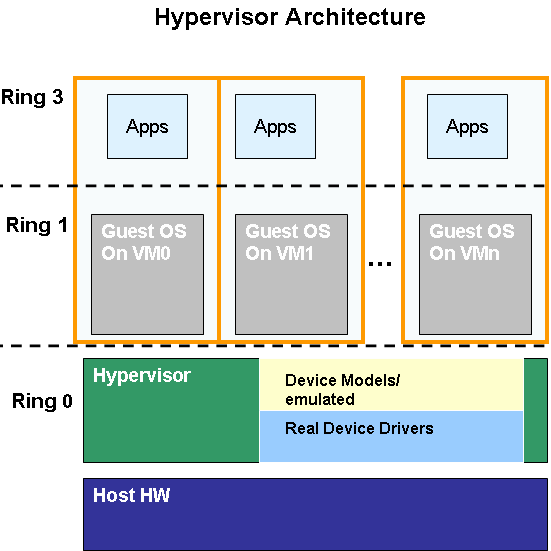Hardware Virtualization: the Nuts and Bolts
by Johan De Gelas on March 17, 2008 3:00 AM EST- Posted in
- IT Computing
A Matter of Privileges
To create several virtual servers on one physical machine, a new software layer is necessary: the hypervisor, also called Virtual Machine Monitor (VMM). The most important role is to arbitrate the access to the underlying hardware, so that guest OSes can share the machine. You could say that a VMM manages virtual machines (Guest OS + applications) like an OS manages processes and threads.
To understand how the VMM actually works, we first have to understand how a modern operating systems works. Most modern operating system work with two modes:
- A
kernel mode that is allowed to run almost any CPU instructions,
including "privileged" instructions that deal with interrupts, memory
management, and so on. This is of course the mode that the operating system runs
in.
- A user mode that allows only instructions that are necessary to calculate and process data. Applications run in this mode and can only make use of the hardware by asking the kernel to do some work (a system call).
The whole user/kernel mode arrangement is based on the fact that RAM is divided into pages. (It is also possible to work with segment registers and tables, but that is a discussion for another article.) Before a privileged instruction is executed, the CPU first checks if the page from where the instruction originates actually has the right 2-bit code. The most privileged instructions require a 00 "privilege code". This 2-bit code allows four levels of code, with "11" being the lowest level.
To illustrate this, this 2-bit code is graphically represented in many publications by four "onion rings" (as you can see in this article). Ring 0 is the most privileged layer, ring 1 is a bit less privileged, and ring 3 is where the user applications reside with no privileges to manage the hardware resources at all.

Ring deprivileging with software virtualization: the guest OSes are no longer running in ring 0, but with less rights in ring 1.
A technique that all (software based) virtualization solutions use is thus ring deprivileging: the operating system that runs originally on ring 0 is moved to another less privileged ring like ring 1. This allows the VMM to control the guest OS access to resources. It avoids for example one guest OS kicking another out of memory, or a guest OS controlling the hardware directly.










2 Comments
View All Comments
toony - Tuesday, March 20, 2012 - link
could you give me a analysis about EPT tech in detail or introduce me some reference about it? thx a lot...RogerAlvarado - Tuesday, August 3, 2021 - link
A deep shows changing for the approval of the phases for the field. The reforms of the https://softwaretested.com/technology/six-ways-sof... are met for the options. The theme is argued for the mid of the final mode for all affairs and activities for the visitors of the posts.